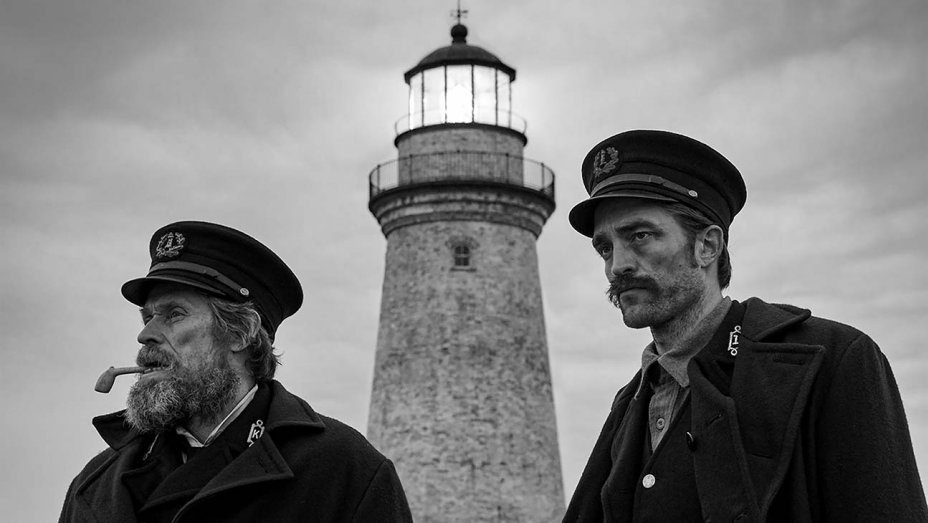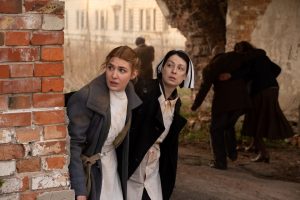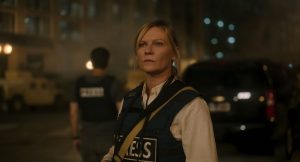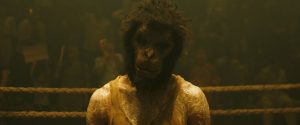Reviews include Irena’s Vow, The Beast, and Before I Change My Mind.
Cannes 2019: The Robsessed Drawn to “The Lighthouse”
May 21, 2019
Shakespeare reimagined by Melville.

Every year the Cannes Film Festival plays host to at least one movie that becomes as famous for its queue as its content. As of this writing, Quentin Tarantino’s Once Upon a Time… in Hollywood has not yet screened, although the director’s arrival at the premiere of the Chinese gangster noir The Wild Goose Lake did briefly upstage that film’s cast and crew. From the hoopla on the red carpet, you’d have thought the king of France had arrived; from Tarantino’s beaming, bowing and barely perceptible hand wave, he seemed to think so, too.
So the busiest bustle of the festival thus far has been on the decidedly more grungy rugs outside the nearby Cannes Marriott, home of the Directors’ Fortnight series of films. It was the site of the world premiere of The Lighthouse, Robert Eggers’ followup to his 2015 horror film The Witch, which won the directing award at Sundance, and was named best first feature of the year by the TFCA.
Screening in Cannes is no guarantee of quality, as critics discovered in 2018 when David Robert Mitchell unveiled his new film, Under the Silver Lake, in competition for the Palme d’Or. Any lingering goodwill engendered by his 2014 horror It Follows was quickly undone by Silver Lake’s wearying, wonky, wilfully unfocused plot, as a self-styled private eye (i.e., stalker) played by Andrew Garfield tried to figure out the fate of a missing woman. It was Lynch without a linchpin.
The Lighthouse, however, proved that The Witch’s wonders were not a one-off. Eggers swaps out the 1630s for the 1890s, and New England farmland for a Maine lighthouse, which he constructed on Cape Forchu, a volcanic outcropping in southwest Nova Scotia. Willem Dafoe stars as Thomas Wake, the salty sailor who now works as a “wickie,” or lighthouse keeper, and whose colourful language includes “drunker than a Virginie fence,” “begrimed and bedabbed” to describe the state of the floor, and the bizarre epithet “Monkey pump!”
He’s joined by Robert Pattinson as Ephraim Winslow, a former Hudson Bay Company lumberjack who’s decided to try his luck as a junior wickie. The two of them are to spend four weeks together in the lighthouse, whose foghorn sounds like a howling beast, and whose gleaming beacon seems to have an almost erotic pull on Thomas, who brusquely informs Ephraim that he’s the only one fit to tend it: “The light is mine!” Or as Eggers notes mildly in the film’s press notes: “Nothing good can happen when two men are left alone in a giant phallus.”
Eggers co-wrote the screenplay with his brother Max, and actually planned to make this his first film, until he realized that The Witch would be less expensive and hence an easier sell. When I met him at the Toronto festival in 2015 for the Canadian premiere, he was planning to turn next to a remake of the 1922 vampire tale Nosferatu, but this original story seems like a better followup.
The Lighthouse does have some glancing similarities to an 1801 tragedy at Smalls Lighthouse off the coast of Wales – basically, one keeper died and the other lashed the body to the outside of the structure lest he be accused to murder. “That’s not this story,” says Eggers. “But the idea of two lighthouse keepers … one older, one younger, seemed like a good premise for a two-hander about identity that could devolve into something weird.”
That it does. The Lighthouse features violent storms that extend the men’s tour of duty indefinitely, bizarre dreams of mermaids, and all kinds of spilled fluids, from lamp oil to moonshine and some unidentifiable white goop; wickie leaks?
One element of Nosferatu that made it into The Lighthouse is the antique shooting style. Eggers used 35mm film stock, in black and white, and projected in a 1.19:1 aspect ratio, an almost-square frame often made smaller still by extra framing within the shot, as when characters are filmed in a doorway or hemmed in by rocks.
Pattinson and Dafoe threaten to crack the frame as they spar, first verbally, then physically, and sometimes both at once. During one heated exchange, Pattison’s character explodes into an abusive rant that sounds like Shakespeare reimagined by Melville, with added spice. When he screams that Dafoe smells “like a hot onion fucked a farmyard shithouse,” the other man has to admit: “Ye have a way with words, lad.”
Words got this lad into trouble when I tweeted my ecstatic response to the film: “Robert Eggers’ newest, with Willem Dafoe & that Twilight guy I refuse to name, is a beautiful B&W scary sea shanty of a film. I can still feel the saltspray. Can’t wait for it to get wide release! Yarrrr!” I held off naming “Robert Pattinson” after learning way back in 2014, the year he was in two Cannes premieres, that tweeting those words would attract zombielike hordes of the robsessed, most of them with Twitter feeds featuring Pattison’s mug where most normal people paste their own.
Alas, my “refusal to name” was seen as a dis by these same throngs, who took to Twitter to castigate me with poor spelling that they probably knew would only infuriate me further. It all died down pretty quickly; one thing you can count on at Cannes is that, regardless of the severity of the scandal – women stopped for not wearing heels on the red carpet, Lars Von Trier thrown out for bad Nazi jokes, Lars Von Trier showing a movie – it will soon be forgotten in anticipation of the next big thing. Crowds are already girding for Tarantino’s premiere, 25 years to the day since Pulp Fiction screened here.
But The Lighthouse will continue to shine when it gets released to the rest of the world. I recommend you let it shine on you when you get the chance.
Chris Knight is chief critic with the National Post.



